
Tsunami Facts
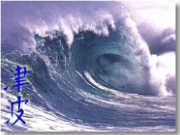 If you live in Nebraska, you don't need to worry much about tsunami disaster preparedness. But, coastal shores attract many people and high populations along the Atlantic and Pacific rims mean that tsunami danger puts many people at risk. This type of natural disaster is one of the most interesting and least understood:
If you live in Nebraska, you don't need to worry much about tsunami disaster preparedness. But, coastal shores attract many people and high populations along the Atlantic and Pacific rims mean that tsunami danger puts many people at risk. This type of natural disaster is one of the most interesting and least understood:
- Tsu-nami means "harbor wave" possibly getting its origins from being nearly undetectable until it reachs land where it does its devastation.
- Along the Washington and Oregon coasts, scientists guess that a devastating tsunami has a good chance of happening in the next 40 years
- In Hawaii, tsunamis are nearly common with a few dozen occuring over the past 100 years.
- In the past 60 years, America has had 6 of these disasters kill over 350 tsunami victims along the West Coast and Hawaii.
- The number of tsunamis per year is rising and the death tolls are climbing - partly due to increasing populations along coastlines.
- 80% of tsunamis occur in the Pacific Ocean.
- Tsunamis travel 400-500 miles per hour in the open ocean. The waves slow and become taller as they approach land.
- Tsunamis are not seasonal but may occur any time. Since they are usually triggered by earthquakes, there is little or no warning that they are approaching.
- Waves are commonly 10 or 20 feet high, but have been over 100 feet high. A 10-foot wave can cause plenty of destruction requiring relief efforts.
- A tsunami is not just one wave, but a series of waves and it may be many minutes from the first wave to the next which may be much larger than the first.
- Tidal wave is a misnomor since tides have nothing to do with tsunamis.
Tsunami Warnings
 Since a tsunami can occur at any time, scientists are developing warning systems. The Pacific Tsunami Warning Center and West Coast/Alaska Tsunami Warning Center have the responsibility of monitoring for and warning about tsunami danger in the Pacific Ocean. The possible bulletins that may be issued are:
Since a tsunami can occur at any time, scientists are developing warning systems. The Pacific Tsunami Warning Center and West Coast/Alaska Tsunami Warning Center have the responsibility of monitoring for and warning about tsunami danger in the Pacific Ocean. The possible bulletins that may be issued are:
- Information: an earth quake has occurred but is not expected to create a tsunami. A single announcement is made.
- Advisory: an earth quake occurred which may create a tsunami. Hourly updates are issued.
- Watch: a tsunami may have been created but is more than 2 hours away from the area under the Watch. Preparation for evacuation should start.
- Warning: a tsunami may have been created and will hit the area being warned soon. Evacuation is strongly advised.
When you are in coastal areas, check at the hotel or city offices for tsunami relief information including evacuation routes and what warnings to listen for. If you feel an earthquake, it may trigger a tsunami. If you notice any abnormal rise or fall of the water along the beach, it may mean the approach of a tsunami. If you hear a abnormal roaring noise from the ocean direction, it could be a tsunami. Police sirens or other warning sirens may be warning of a tsunami.
Before a Tsunami
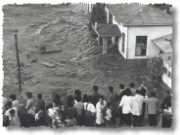 Preparedness for all potential disasters is important. Tsunamis are relatively rare, but preparation for them is simple. Evacuation is the only option - you don't seek shelter in the basement, build a sandbag barricade, or ride it out, you evacuate. Some preparation hints to help you be a tsunami survivor include:
Preparedness for all potential disasters is important. Tsunamis are relatively rare, but preparation for them is simple. Evacuation is the only option - you don't seek shelter in the basement, build a sandbag barricade, or ride it out, you evacuate. Some preparation hints to help you be a tsunami survivor include:
- Know your distance from the shore and height above sea level. This is important when evacuation orders are issued.
- Understand the risk factor for your area. The shore geography, slope of land, and other factors will effect the risk.
- Plan evacuation routes from all locations you and your family members may be - home, school, work, recreation area. Evacuation is your survival plan. Some communities have posted evacuation routes.
- Your evacuation destination should be at least 100 feet above sea level or 2 miles inland from the coast. You should be able to cover this distance on foot in 15 minutes.
- Evacuation is typically a short distance and in fact will probably be faster by foot instead of by car.
- Practice your plan. Practice it again. Practice it at least each year.
- Take your family on a picnic hike to your evacuation destination to practice the route.
- Discuss tsunami facts and danger with everyone in your family and make sure they know what to listen for and what to do.
- Decide if you need tsunami flood insurance.
- Don't have your home right on the coast. Buy or build a few hundred feet back from the shore.
- Make sure your house is at least 15 feet above the high tide line since most tsunami waves are under 10 feet high.
- Landscape your property to divert incoming waves and retreating flood waters. Get professional advice.
During a Tsunami
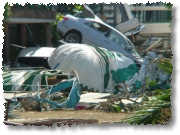 If you feel a strong earthquake on the coast, first of all protect yourself from the dangers of the earthquake then immediately evacuate your family. A tsunami disaster may occur in just a few minutes.
If you feel a strong earthquake on the coast, first of all protect yourself from the dangers of the earthquake then immediately evacuate your family. A tsunami disaster may occur in just a few minutes.
If there is a Tsunami Watch:
- Stay Calm.
- Tune in to local emergency radio, Coast Guard, or NOAA Weather for tsunami information updates.
- Locate and check your family emergency kit.
- Review evacuation route and plans with family members.
- Store outdoor toys, furniture, other items that may wash away.
- Prepare to evacuate.
- Call your out-of-town contact to let them know your plans.
- Grab your emergency kit.
- Evacuate your family.
- Use your portable radio to listen for updates.
- Call your out-of-town contact.
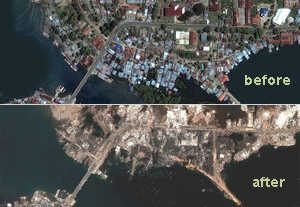
After a Tsunami
 After the initial destruction and efforts to rescue tsunami survivors, much of the challenges and clean-up are similar to floods. Contamination of drinking water, food, and living areas are a big problem. Depending on the location, insects, heat, and other natural hazards can raise the risk of injury and death. The fact is, most tsunami victims are from drowning but trauma injuries from people being tossed around by the violent waters also are common and contribute to death tolls.
After the initial destruction and efforts to rescue tsunami survivors, much of the challenges and clean-up are similar to floods. Contamination of drinking water, food, and living areas are a big problem. Depending on the location, insects, heat, and other natural hazards can raise the risk of injury and death. The fact is, most tsunami victims are from drowning but trauma injuries from people being tossed around by the violent waters also are common and contribute to death tolls.
- Return only after authorities announce the all clear.
- Provide tsunami relief to people needing first aid or are trapped.
- Check with neighbors to see if anyone needs assistance.
- Keep an eye out for hazards such as power lines, gas leaks, broken water mains, snakes, scared or wild animals.
- Wear rubber boots and gloves before starting cleanup to reduce risk of cuts, infection, and sickness.
- If your house was hit or flooded, check the outside for structural integrity before entering, then:
- Check for fire hazards, such as gas leaks or spilled flammable liquids.
- Turn electricity off until the house has dried out.
- Check the water lines for damage. Do not use your water source until you are sure it is pure.
- Check the sewage system for damage.
- Contact your insurance representative to make a claim and start the clean-up process.
- Discard all food that came in contact with the water if it is not sealed in a waterproof container. Unopened, commercially sealed foods such as canned foods can be salvaged. Remove the labels, wash the cans, and disinfect with bleach solution. Write the contents on the can.
- All appliances, heating system, and electricity system that have been flooded need to be cleaned and dried before use. You should have a professional check out these items.
- Be especially conscious of cleanliness. Wash your hands with soap often and use hand sanitizers such as Purell. Water from a tsunami has picked up all the filth, trash, and micro-organisms laying around and mixed it into a stew of sewage that was deposited all over everything it came in contact with. Washing before and after preparing food, after working, using the bathroom, and during the day will help prevent sickness in this stressful time.
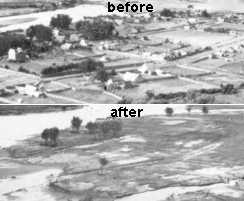
Tsunami disaster links of interest:
Tsunami Survival Stories
USGS Life of a Tsunami
West Coast and Alaska Tsunami Warning Center
Pacific Tsunami Warning Center

Find Emergency and Disaster Info at www.EmergencyDude.com

